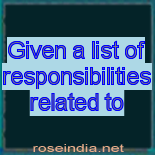The Bean Provider defines the APPLICATION exceptions [BUSINESS exceptions] in the throws clauses of the methods of the home and component interfaces. Because application exceptions are intended to be handled by the CLIENT, and NOT by the SYSTEM administrator, they should be used only for reporting BUSINESS logic exceptions, NOT for reporting SYSTEM level problems.
The Bean Provider is responsible for throwing the appropriate APPLICATION exception from the business method to report a business logic exception to the client. Because the application exception DOES NOT automatically result in marking the transaction for rollback, the Bean Provider MUST do one of the following to ensure data integrity before throwing an application exception from an enterprise bean instance:
Ensure that the instance is in a state such that a client's attempt to continue and/or commit the transaction does not result in loss of data integrity. For example, the instance throws an application exception indicating that the value of an input parameter was invalid before the instance performed any database updates.
Mark the transaction for rollback using the EJBContext.setRollbackOnly() method BEFORE throwing an application exception. Marking the transaction for rollback will ensure that the transaction can never commit.
An APPLICATION exception class MUST be a subclass (direct or indirect) of java.lang.Exception. An application exception class MUST NOT be defined as a subclass of the java.lang.RuntimeException, or of the java.rmi.RemoteException. These are reserved for SYSTEM exceptions.
The Bean Provider is also responsible for using the standard EJB APPLICATION exceptions (javax.ejb.CreateException, javax.ejb.RemoveException, javax.ejb.FinderException, and subclasses thereof).
The enterprise bean business method, onMessage method, or container callback method may encounter various exceptions or errors that prevent the method from successfully completing. Typically, this happens because the exception or error is unexpected, or the exception is expected but the EJB Provider does not know how to recover from it. Examples of such exceptions and errors are: failure to obtain a database connection, JNDI exceptions, unexpected RemoteException from invocation of other enterprise beans, unexpected RuntimeException, JVM errors, and so on.
Bean Providers MAY define subclasses of the standard EJB application exceptions and throw instances of the subclasses in the enterprise bean methods. A subclass will typically provide more information to the client that catches the exception.
If the enterprise bean method encounters a SYSTEM-level exception or error that does not allow the method to successfully complete (failure to obtain a database connection, JNDI exceptions, unexpected RemoteException from invocation of other enterprise beans, unexpected RuntimeException, JVM errors), the method should throw a suitable non-application exception that is compatible with the method's throws clause. While the EJB specification does not prescribe the exact usage of the exception, it encourages the Bean Provider to follow these guidelines:
If the bean method encounters a RuntimeException or error, it should simply propagate the error from the bean method to the Container (i.e., the bean method does not have to catch the exception).
If the bean method performs an operation that results in a checked exception that the bean method CANNOT recover, the bean method should throw the javax.ejb.EJBException that wraps the original exception.
Any other unexpected error conditions should be reported using the javax.ejb.EJBException.
Note that the javax.ejb.EJBException is a subclass of the java.lang.RuntimeException, and therefore it does not have to be listed in the throws clauses of the business methods.
The Container catches a non-application [SYSTEM] exception; logs it (which can result in ALERTING the SYSTEM Administrator); and, unless the bean is a message-driven bean, throws the java.rmi.RemoteException (or subclass thereof) to the client if the client is a REMOTE client, or throws the javax.ejb.EJBException (or subclass thereof) to the client if the client is a LOCAL client. The Bean Provider can rely on the Container to perform the following tasks when catching a non-application exception:
The transaction in which the bean method participated will be rolled back.
No other method will be invoked on an instance that threw a non-application exception.

The NoSuchEntityException is a subclass of EJBException. It should be thrown by the ENTITY bean class methods to indicate that the underlying ENTITY has been removed from the database. An entity bean class typically throws this exception from the ejbLoad and ejbStore methods, and from the methods that implement the business methods defined in the COMPONENT interface.

